Coordination of Automobile Supply Chain Considering Relative Endurance Level under the Dual-Credit Policy
Abstract
1. Introduction
2. The Model Formulation
2.1. Assumptions and Notations
2.2. Demand Function
2.3. Equilibrium Modeling
2.3.1. Decentralized Decision Making
2.3.2. Centralized Decision Making
3. Supply Chain Coordination
3.1. Revenue-Sharing Contract
3.2. Nash Negotiation
4. Numerical Analysis
5. Conclusions
6. Limitations and Future Research
Author Contributions
Funding
Institutional Review Board Statement
Informed Consent Statement
Data Availability Statement
Acknowledgments
Conflicts of Interest
Appendix A
References
- Ministry of Industry and Information Technology Equipment Industry Development Center. Available online: http://www.miit-eidc.org.cn/art/2022/7/5/art_88_31014.html (accessed on 1 August 2022).
- Tang, B.J.; Liu, J.P. Outlook for the development of China’s new energy vehicle industry. J. Beijing Univ. Technol. (Soc. Sci. Ed.) 2015, 17, 1–6. [Google Scholar] [CrossRef]
- Lin, B.Q.; Li, L. Transformation of China’s energy structure under environmental governance constraints—An analysis based on coal and peak CO2. China Soc. Sci. 2015, 9, 84–107, 205. [Google Scholar]
- Li, S.X.; Liu, Y.Q.; Wang, Y.; Zhang, L. Analysis of China’s new energy vehicle industry development policy based on market performance. China’s Popul. Resour. Environ. 2016, 26, 158–166. [Google Scholar]
- Zhang, L.; Liu, Y. Analysis of New Energy vehicles industry policy in China’s cities from the perspective of policy instruments. Energy Procedia 2016, 104, 437–442. [Google Scholar] [CrossRef]
- Ren, J. New energy vehicle in China for sustainable development: Analysis of success factors and strategic implications. Transp. Res. Part D Transp. Environ. 2018, 59, 268–288. [Google Scholar] [CrossRef]
- Gu, X.; Ieromonachou, P.; Zhou, L.; Tseng, M.-L. Developing pricing strategy to optimise total profits in an electric vehicle battery closed loop supply chain. J. Clean. Prod. 2018, 203, 376–385. [Google Scholar] [CrossRef]
- Xie, J.P.; Li, J.; Yang, F.F. Multi level contract decision optimization of closed-loop supply chain for new energy vehicles. J. Manag. Eng. 2020, 34, 14. [Google Scholar]
- Zhu, X.; Ren, M.; Wu, G.; Pei, J.; Pardalos, P.M. Promoting new energy vehicles consumption: The effect of implementing carbon regulation on automobile industry in China. Comput. Ind. Eng. 2019, 135, 211–226. [Google Scholar] [CrossRef]
- Zhao, J.-H.; Zeng, D.-L.; Che, L.-P.; Zhou, T.-W.; Hu, J.-Y. Research on the profit change of new energy vehicle closed-loop supply chain members based on government subsidies. Environ. Technol. Innov. 2020, 19, 100937. [Google Scholar] [CrossRef]
- Shen, C.R.; Li, L.Z. Research on automobile supply chain decision-making considering government subsidies in the context of new energy. Pract. Cogn. Math. 2019, 49, 79–88. [Google Scholar]
- Gong, B.; Xia, X.; Cheng, J. Supply-Chain Pricing and Coordination for New Energy Vehicles Considering Heterogeneity in Consumers’ Low Carbon Preference. Sustainability 2020, 12, 1306. [Google Scholar] [CrossRef]
- Mu, D.; Yang, J.; Li, X. The influence of closed-loop supply chain enterprise cooperation on the recovery and reuse of power batteries for new energy vehicles. Supply Chain. Manag. 2021, 2, 54–67. [Google Scholar] [CrossRef]
- Shen, M.J. Research on Resource Input Decision of new Energy Vehicle Supply Chain Based on Cooperation and Sharing Mode. Master’s Thesis, China University of Mining and Technology, Beijing, China, 2021. [Google Scholar] [CrossRef]
- Wang, W.B.; Lv, J.; Zhang, M.Y.; Lv, T.; Bian, W.L. Research on resource input strategy of new energy vehicle supply chain under cooperation mode. Ind. Technol. Econ. 2021, 40, 33–41. [Google Scholar]
- Sun, H.F.; Wang, Y. Horizontal competition and cooperation R&D game of new energy vehicle supply chain under the policy of “dual-credits”. Pract. Cogn. Math. 2020, 50, 11. [Google Scholar]
- Zheng, C.; Zhao, H.; Li, Z. Research on R&D subsidy of new energy vehicle industry under dual-credit policy. Res. Manag. 2019, 40, 126–133. [Google Scholar] [CrossRef]
- Tang, H.; Yang, F.; Xu, W.; Zhao, L.Q. Research on the production and pricing of secondary automobile supply chain considering consumer preference under the dual-credit system. Ind. Eng. Manag. 2021, 26, 121–129. [Google Scholar] [CrossRef]
- Yu, X.H.; Ye, Z.X.; Li, M. Subsidy decline-optimization analysis of production decision-making in two-level supply chain under the dual-credit policy. Oper. Manag. 2021, 30, 42–49. [Google Scholar]
- Peng, L.; Li, Y.; Yu, H. Effects of dual credit policy and consumer preferences on production decisions in automobile supply chain. Sustainability 2021, 13, 5821. [Google Scholar] [CrossRef]
- Cheng, Y.W.; Mu, D. Optimization of subsidy strategy for new energy vehicle supply chain based on SD dynamic game. China’s Popul. Resour. Environ. 2018, 28, 11. [Google Scholar]
- Zhang, Q.; Li, Y.M.; Tang, Y.Y. A Study on the Impact of the “Dual-Credit” Policy of New Energy Vehicles on Manufacturers’ Strategies and Social Welfare. Syst. Eng. Theory Pract. 2020, 40, 20. [Google Scholar]
- Li, J.; Ku, Y.; Liu, C.; Zhou, Y. Dual credit policy: Promoting new energy vehicles with battery recycling in a competitive environment? J. Clean. Prod. 2020, 243, 118452. [Google Scholar] [CrossRef]
- Ma, L.; Guo, P.H. Research on endurance decision-making of new energy vehicle industry chain under the dual-credit system. Technol. Manag. Res. 2019, 39, 151–161. [Google Scholar]
- Ma, L.; Zhong, W.J.; Mei, S.E. Research on subsidy strategy of new energy vehicle industry chain based on endurance demand. Syst. Eng. Theory Pract. 2018, 38, 1759–1767. [Google Scholar]
- Ma, L.; Ren, H.W. Research on technological innovation game of new energy vehicles for endurance. Soft Sci. 2018, 32, 73–79. [Google Scholar] [CrossRef]
- Chen, W.W.; Xu, M.Z.; Xing, Q.S. Research on hierarchical delay layout of new energy vehicle charging station considering endurance. Transp. Syst. Eng. Inf. 2020, 20, 156–162. [Google Scholar] [CrossRef]
- Zeng, X.B.; Zhu, H.; Song, K.T.; Xie, F.; Li, Y. Development trend of long-range pure electric vehicles and changes in demand for power battery systems. Era Car 2018, 7, 89–90. [Google Scholar]
- Jia, J.X.; Zhao, X.K. Battery endurance and recovery strategy of new energy vehicle supply chain under government subsidies. J. Syst. Eng. 2022, 37, 14. [Google Scholar]
- Masatlioglu, Y.; Uler, N. Understanding the reference effect. Games Econ. Behav. 2013, 82, 403–423. [Google Scholar] [CrossRef]
- Stewart, D.D.; Stewart, C.B.; Walden, J. Self-Reference Effect and the Group-Reference Effect in the Recall of Shared and Unshared Information in Nominal Groups and Interacting Groups. Group Process. Intergroup Relat. 2007, 10, 323–339. [Google Scholar] [CrossRef]
- Lu, C.; Wang, Q.Q.; Chen, Q. Coordination of automotive supply chain considering price, emission reduction and endurance under the dual-credit policy. Syst. Eng. Theory Pract. 2021, 41, 2595–2608. [Google Scholar]
- Cheng, Y.; Fan, T. Production coopetition strategies for an FV automaker and a competitive NEV automaker under the dual-credit policy. Omega 2021, 103, 102391. [Google Scholar] [CrossRef]
- Li, X.; Ai, X.Z.; Tang, X.W. Technology innovation value and spillover effect based on supply chain competition. J. Syst. Eng. 2017, 32, 10. [Google Scholar]
- Qi, F.; Lu, L.X. Supply Chain Contracting Under Competition: Bilateral Bargaining vs. Stackelberg. Prod. Oper. Manag. 2013, 22, 661–675. [Google Scholar]
- Zhou, D.; Yu, Y.; Wang, Q.; Zha, D. Effects of a generalized dual-credit system on green technology investments and pricing decisions in a supply chain. J. Environ. Manag. 2019, 247, 269–280. [Google Scholar] [CrossRef] [PubMed]
- Home of Cars. Available online: https://car.autohome.com.cn/config/spec/46979.html (accessed on 1 August 2022).
- Internet Weekly. Available online: https://baijiahao.baidu.com/s?id=1710118015542257530 (accessed on 1 August 2022).
- Ke, R.; Zhao, J.H.; Wei, H.R.; Ji, Y.Y. Optimization and Coordination Mechanism of New Energy vehicle supply chain considering Consumer preference. Mech. Des. Res. 2022, 38, 154–160. [Google Scholar] [CrossRef]
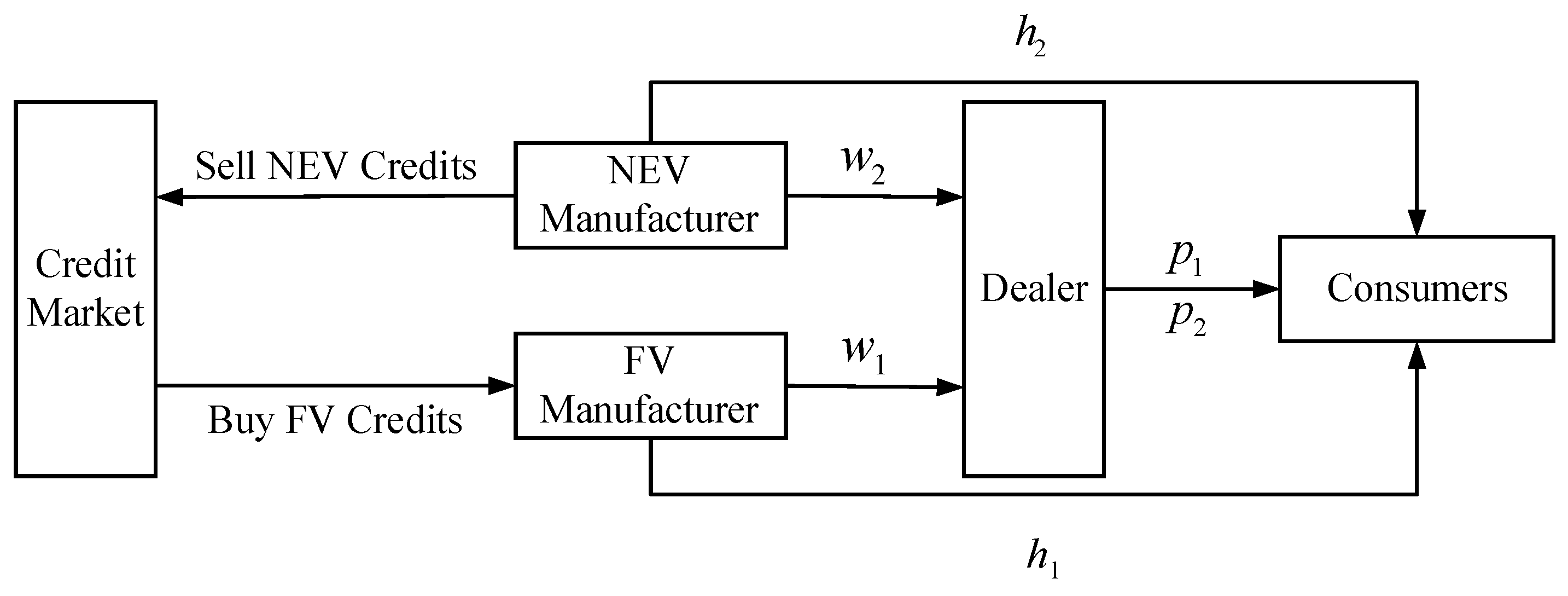
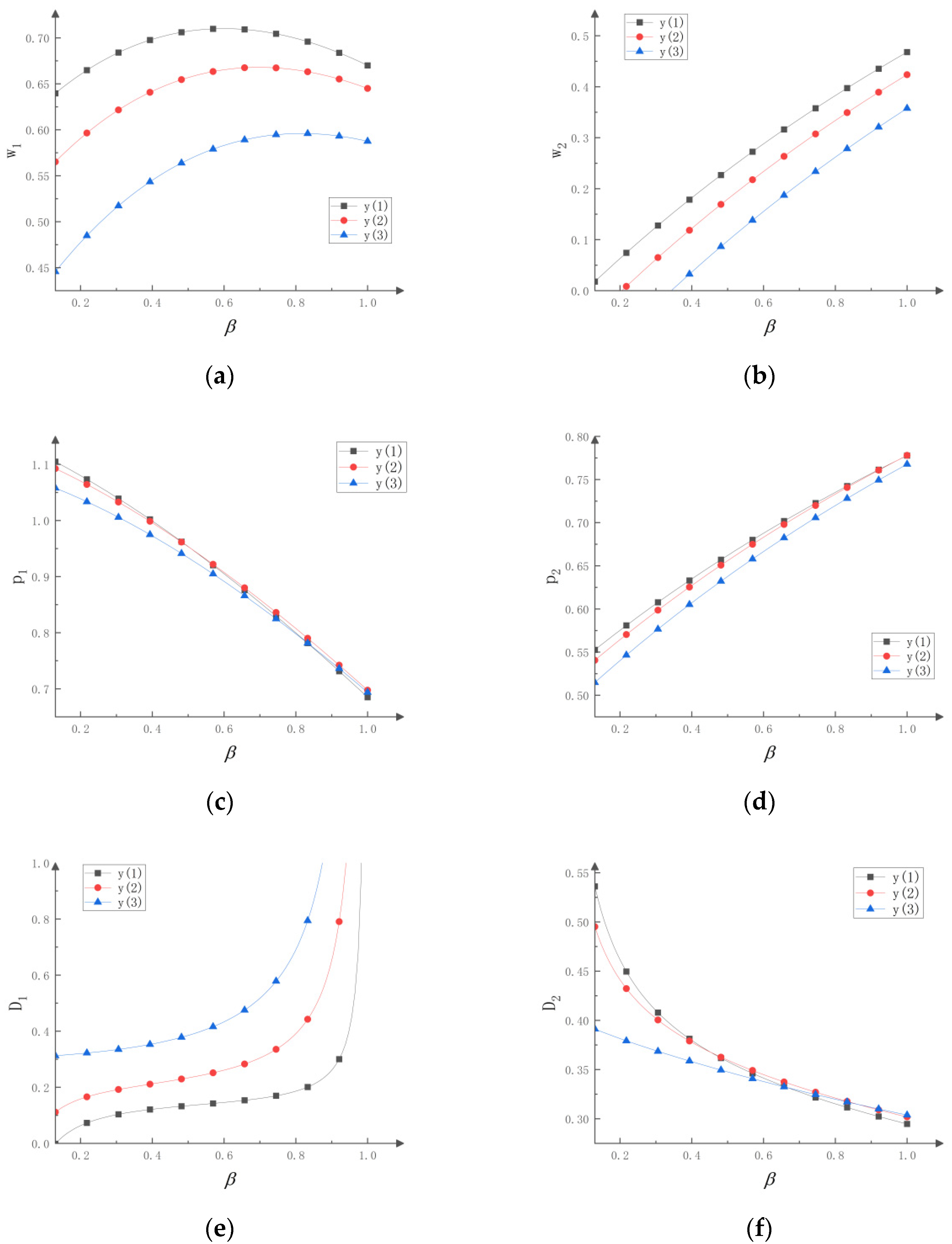
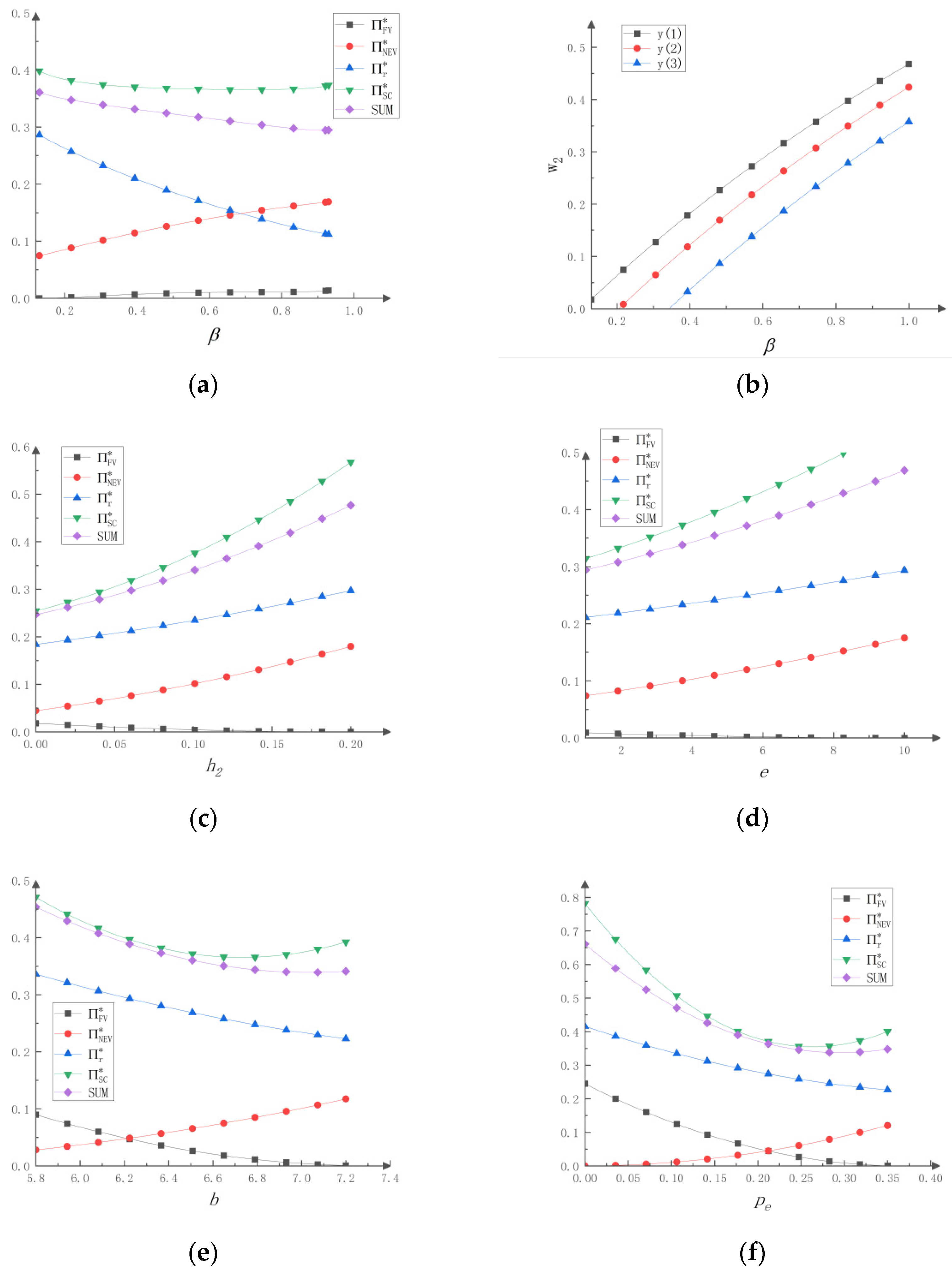
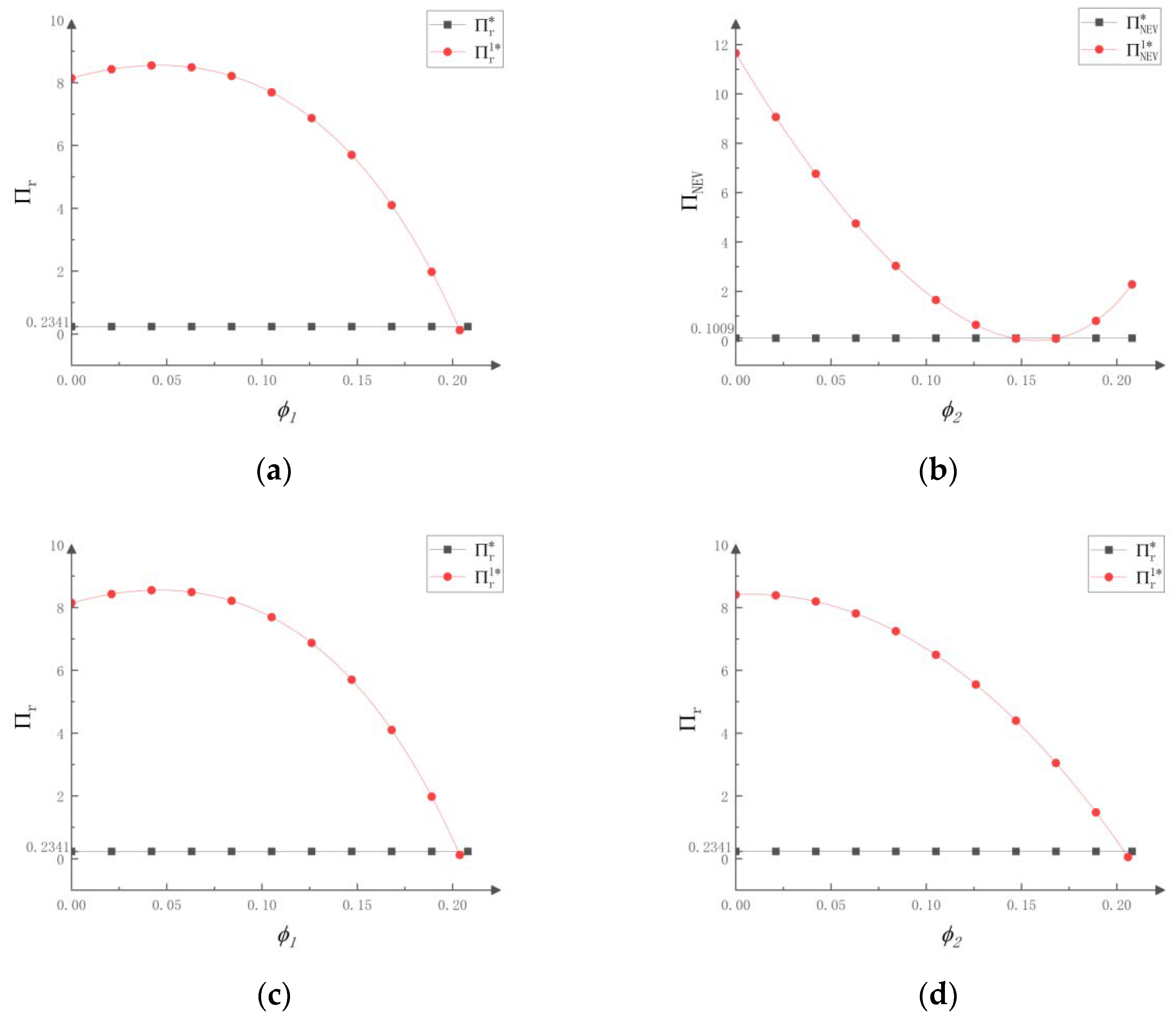
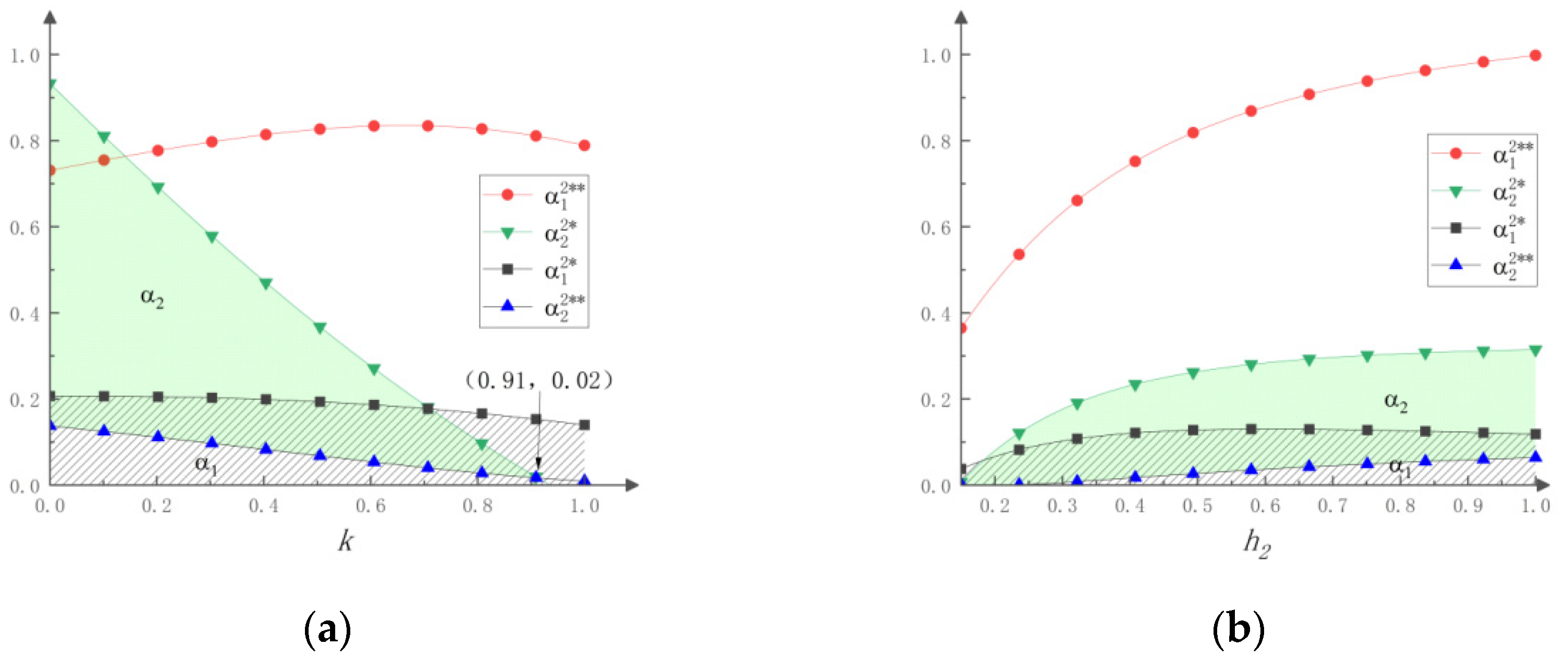
| Notation | Definition | |
|---|---|---|
| Parameters | i = 1, 2 | 1 means FV, 2 means NEV |
| ci | Unit production cost | |
| Di | Market demand | |
| Profit | ||
| h2 | NEV of cruising capability | |
| h1 | FV of cruising capability | |
| Customer reservation price, | ||
| β | Consumer preference for new energy vehicles, | |
| k | Consumer endurance concerns, | |
| a | FV automaker’s standard level of fuel consumption | |
| b | FV automaker’s actual level of fuel consumption | |
| e | NEV credits calculation factor | |
| pe | Value of energy credits | |
| Decision variables | pi | Retail price, |
| wi | Wholesale price, | |
Publisher’s Note: MDPI stays neutral with regard to jurisdictional claims in published maps and institutional affiliations. |
© 2022 by the authors. Licensee MDPI, Basel, Switzerland. This article is an open access article distributed under the terms and conditions of the Creative Commons Attribution (CC BY) license (https://creativecommons.org/licenses/by/4.0/).
Share and Cite
Xu, Y.; Ma, X.; Zhou, G. Coordination of Automobile Supply Chain Considering Relative Endurance Level under the Dual-Credit Policy. Sustainability 2022, 14, 13704. https://doi.org/10.3390/su142113704
Xu Y, Ma X, Zhou G. Coordination of Automobile Supply Chain Considering Relative Endurance Level under the Dual-Credit Policy. Sustainability. 2022; 14(21):13704. https://doi.org/10.3390/su142113704
Chicago/Turabian StyleXu, Yuanyuan, Xiuyan Ma, and Gengui Zhou. 2022. "Coordination of Automobile Supply Chain Considering Relative Endurance Level under the Dual-Credit Policy" Sustainability 14, no. 21: 13704. https://doi.org/10.3390/su142113704
APA StyleXu, Y., Ma, X., & Zhou, G. (2022). Coordination of Automobile Supply Chain Considering Relative Endurance Level under the Dual-Credit Policy. Sustainability, 14(21), 13704. https://doi.org/10.3390/su142113704





